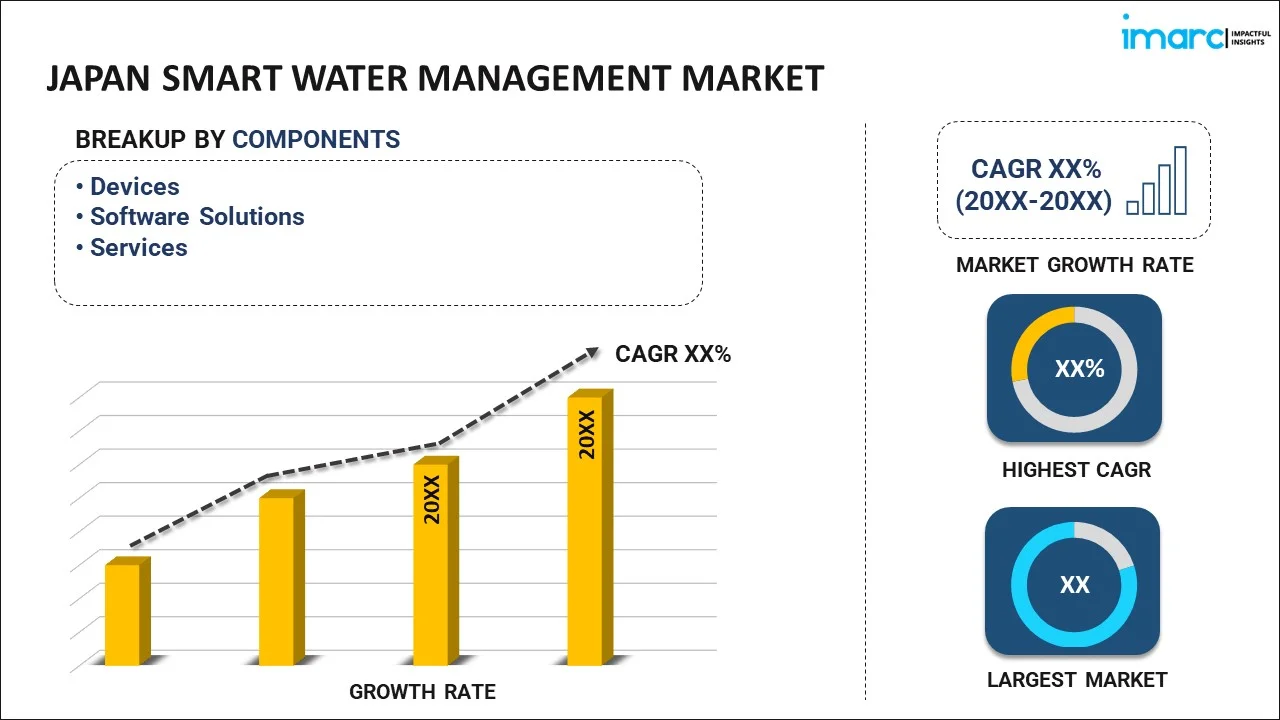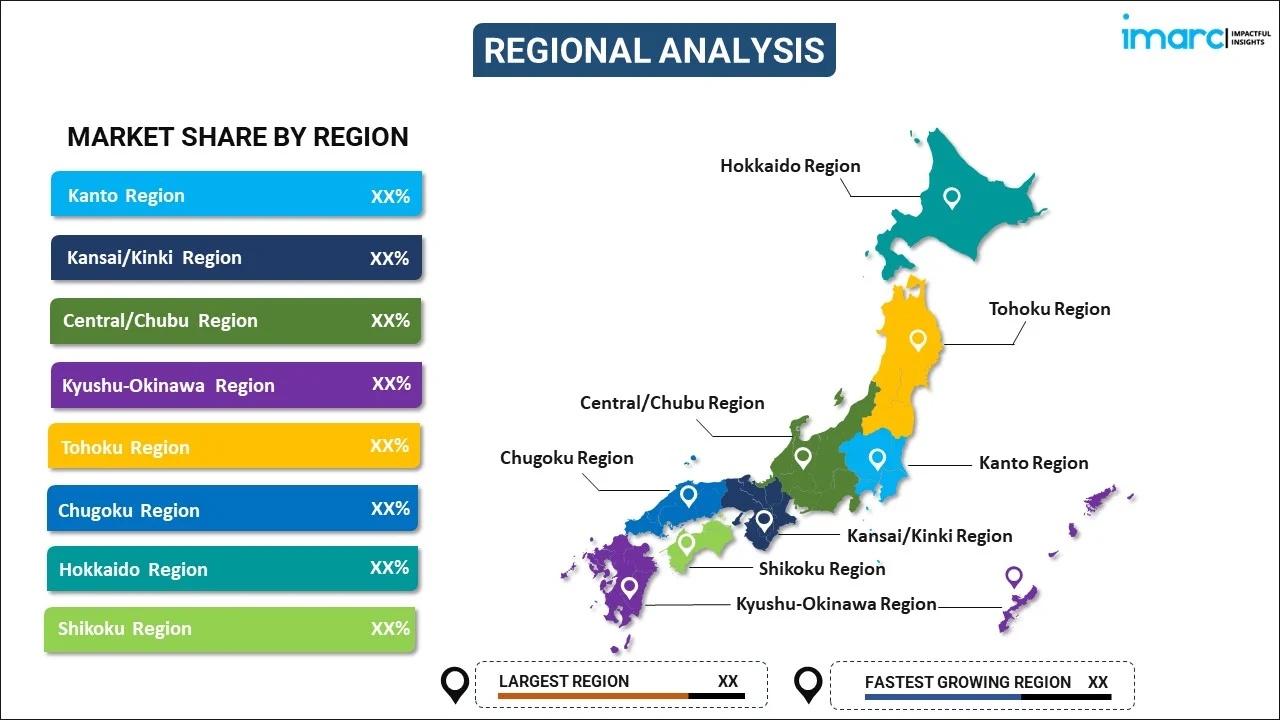
Japan Smart Water Management Market Report by Component (Devices, Software Solutions, Services), Application (Residential, Commercial and Industrial), and Region 2025-2033
Market Overview:
Japan smart water management market size reached USD 1.2 Billion in 2024. Looking forward, IMARC Group expects the market to reach USD 2.0 Billion by 2033, exhibiting a growth rate (CAGR) of 6% during 2025-2033. The increasing demand for real-time data and analytics, which enables water utilities to make informed decisions, optimize resource allocation, and respond quickly to issues, is driving the market.
|
Report Attribute
|
Key Statistics
|
|---|---|
|
Base Year
|
2024
|
|
Forecast Years
|
2025-2033
|
|
Historical Years
|
2019-2024
|
|
Market Size in 2024
|
USD 1.2 Billion |
|
Market Forecast in 2033
|
USD 2.0 Billion |
| Market Growth Rate 2025-2033 | 6% |
Smart water management refers to the utilization of technology and data-driven solutions to optimize the sustainable use, distribution, and conservation of water resources. By employing sensors, meters, and advanced analytics, smart water management systems enable real-time monitoring of water quality, consumption, and infrastructure conditions. These systems enhance efficiency by detecting leaks, minimizing wastage, and optimizing water distribution networks. Additionally, they facilitate predictive modeling for improved decision-making and resource allocation. By integrating Internet of Things (IoT) devices and automation, smart water management contributes to the overall resilience of water supply systems, ensuring a more reliable and sustainable water infrastructure. This approach not only addresses the challenges posed by water scarcity but also promotes environmental conservation and supports the long-term viability of water resources for communities and industries alike.
Japan Smart Water Management Market Trends:
The smart water management market in Japan is experiencing robust growth, primarily driven by a confluence of factors that underscore the pressing need for efficient water resource utilization. Firstly, the escalating regional population and urbanization trends have intensified water demand, necessitating innovative solutions to manage this precious resource effectively. Moreover, the rising awareness of environmental sustainability has propelled governments and industries to adopt smart water management technologies as a crucial component of their eco-friendly initiatives. Furthermore, the increasing frequency and severity of water-related challenges, such as droughts and water scarcity, have accentuated the urgency for proactive measures. In response, industries are recognizing the economic benefits of implementing smart water solutions, not only in terms of cost savings but also in meeting stringent regulatory standards. Additionally, advancements in sensor technologies, data analytics, and IoT, which have empowered the development of sophisticated water management systems, are expected to drive the market in Japan during the forecast period.
Japan Smart Water Management Market Segmentation:
IMARC Group provides an analysis of the key trends in each segment of the market, along with forecasts at the country level for 2025-2033. Our report has categorized the market based on component and application.
Component Insights:

- Devices
- Advanced Water Meters
- Meter Read Technology
- Software Solutions
- Asset Management
- Distribution Network Monitoring
- Supervisory Control and Data Acquisition (SCADA)
- Meter Data Management (MDM)
- Advance Analytics
- Others
- Services
- Managed Services
- Professional Services
The report has provided a detailed breakup and analysis of the market based on the component. This includes devices (advanced water meters and meter read technology), software solutions (asset management, distribution network monitoring, supervisory control and data acquisition (SCADA), meter data management (MDM), advance analytics, and others), and services (managed services and professional services).
Application Insights:
- Residential
- Commercial and Industrial
A detailed breakup and analysis of the market based on the application have also been provided in the report. This includes residential and commercial and industrial.
Regional Insights:

- Kanto Region
- Kansai/Kinki Region
- Central/ Chubu Region
- Kyushu-Okinawa Region
- Tohoku Region
- Chugoku Region
- Hokkaido Region
- Shikoku Region
The report has also provided a comprehensive analysis of all the major regional markets, which include Kanto Region, Kansai/Kinki Region, Central/ Chubu Region, Kyushu-Okinawa Region, Tohoku Region, Chugoku Region, Hokkaido Region, and Shikoku Region.
Competitive Landscape:
The market research report has also provided a comprehensive analysis of the competitive landscape. Competitive analysis such as market structure, key player positioning, top winning strategies, competitive dashboard, and company evaluation quadrant has been covered in the report. Also, detailed profiles of all major companies have been provided.
Japan Smart Water Management Market Report Coverage:
| Report Features | Details |
|---|---|
| Base Year of the Analysis | 2024 |
| Historical Period | 2019-2024 |
| Forecast Period | 2025-2033 |
| Units | Billion USD |
| Scope of the Report | Exploration of Historical and Forecast Trends, Industry Catalysts and Challenges, Segment-Wise Historical and Predictive Market Assessment:
|
| Components Covered |
|
| Applications Covered | Residential, Commercial and Industrial |
| Regions Covered | Kanto Region, Kansai/Kinki Region, Central/ Chubu Region, Kyushu-Okinawa Region, Tohoku Region, Chugoku Region, Hokkaido Region, Shikoku Region |
| Customization Scope | 10% Free Customization |
| Post-Sale Analyst Support | 10-12 Weeks |
| Delivery Format | PDF and Excel through Email (We can also provide the editable version of the report in PPT/Word format on special request) |
Key Questions Answered in This Report:
- How has the Japan smart water management market performed so far and how will it perform in the coming years?
- What has been the impact of COVID-19 on the Japan smart water management market?
- What is the breakup of the Japan smart water management market on the basis of component?
- What is the breakup of the Japan smart water management market on the basis of application?
- What are the various stages in the value chain of the Japan smart water management market?
- What are the key driving factors and challenges in the Japan smart water management?
- What is the structure of the Japan smart water management market and who are the key players?
- What is the degree of competition in the Japan smart water management market?
Key Benefits for Stakeholders:
- IMARC’s industry report offers a comprehensive quantitative analysis of various market segments, historical and current market trends, market forecasts, and dynamics of the Japan smart water management market from 2019-2033.
- The research report provides the latest information on the market drivers, challenges, and opportunities in the Japan smart water management market.
- Porter's five forces analysis assist stakeholders in assessing the impact of new entrants, competitive rivalry, supplier power, buyer power, and the threat of substitution. It helps stakeholders to analyze the level of competition within the Japan smart water management industry and its attractiveness.
- Competitive landscape allows stakeholders to understand their competitive environment and provides an insight into the current positions of key players in the market.
Need more help?
- Speak to our experienced analysts for insights on the current market scenarios.
- Include additional segments and countries to customize the report as per your requirement.
- Gain an unparalleled competitive advantage in your domain by understanding how to utilize the report and positively impacting your operations and revenue.
- For further assistance, please connect with our analysts.
 Inquire Before Buying
Inquire Before Buying
 Speak to an Analyst
Speak to an Analyst
 Request Brochure
Request Brochure
 Request Customization
Request Customization




.webp)




.webp)












